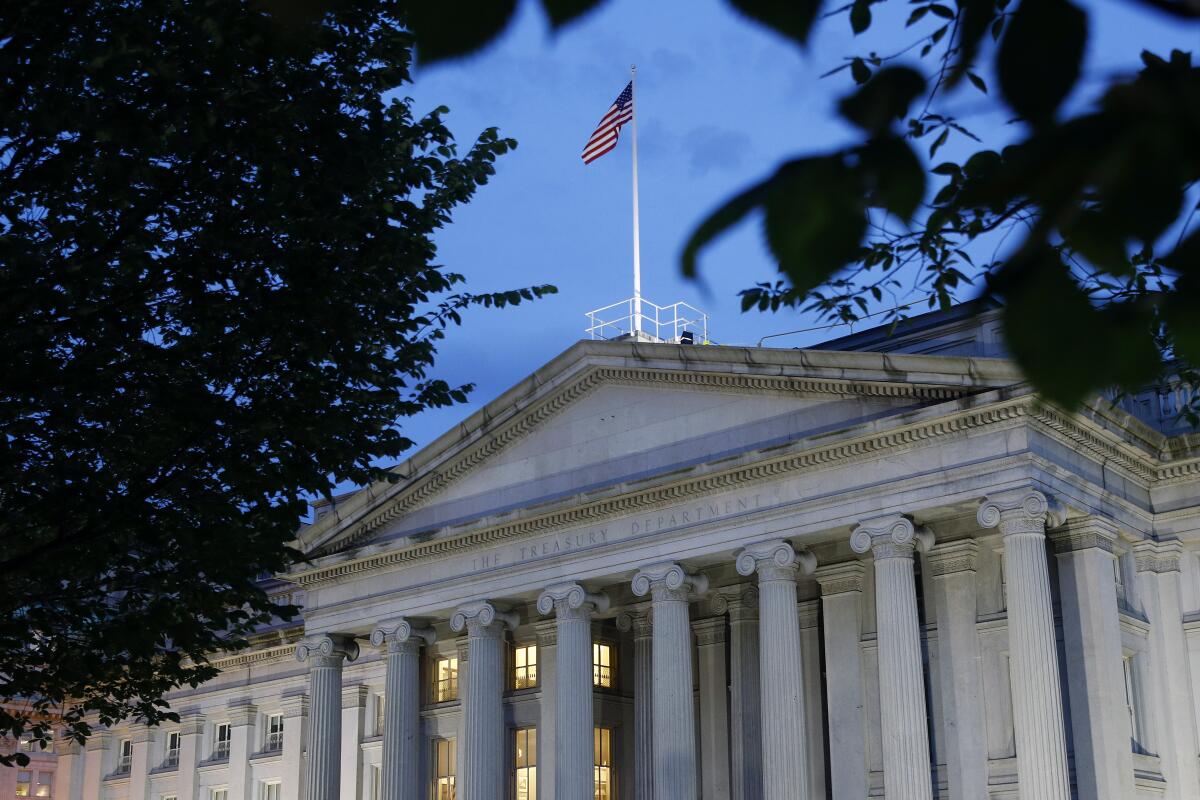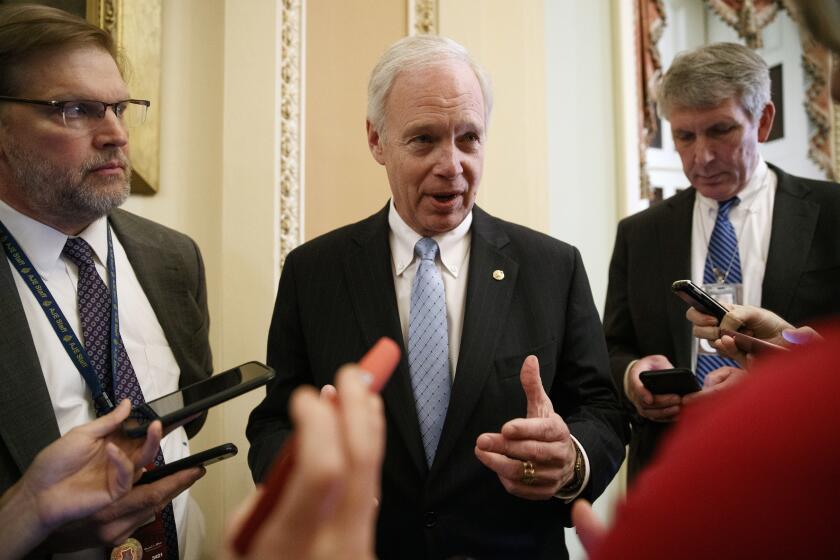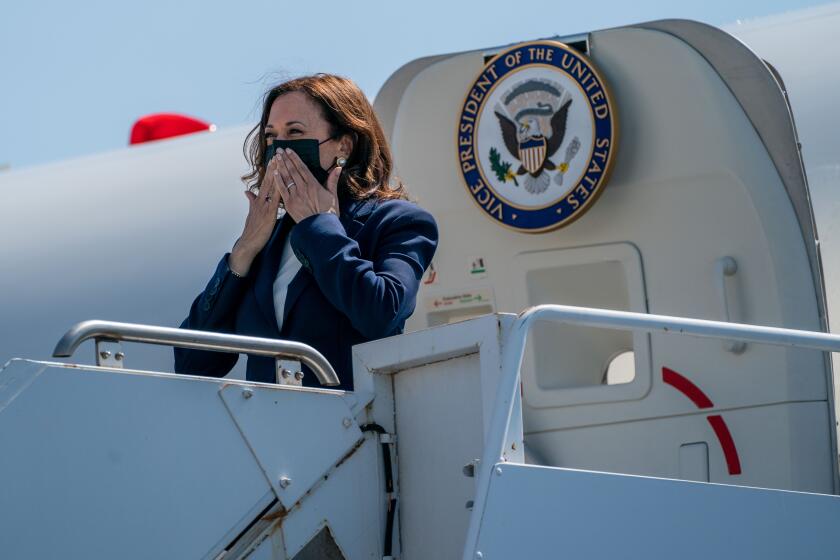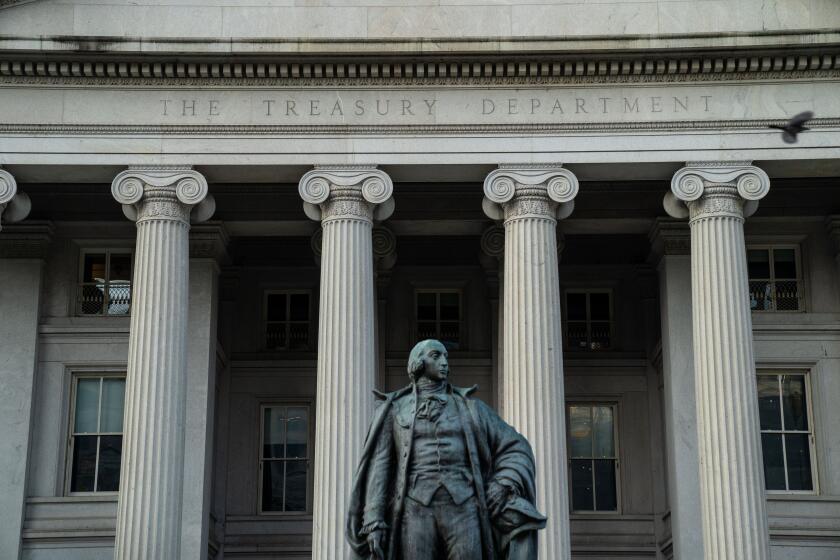What will happen if Congress doesn’t raise the federal debt limit?

- Share via
When power in Washington is split between Democrats and Republicans, chances are good that lawmakers will reach an impasse over what once was a routine part of the budget process: raising the federal debt limit. We’ve seen it in 1985, 1995 (a standoff that lasted into 1996), 2002, 2003, 2011, 2013, 2014 and 2015, and it’s happening again now.
The dispute this time isn’t whether to raise the debt limit — both sides agree that it must be done — but how to do it. Senate Republicans are insisting not only that Democrats provide all the votes for the increase, but also that they attach the increase to a budget “reconciliation” bill. That bill, which cannot be filibustered, would expand social spending programs by $3.5 trillion over 10 years, financed largely through tax increases on corporations and high-income Americans.
With control of the Senate evenly divided, Republicans can block any attempt to increase the debt limit through a process other than reconciliation. They used that power twice this week, first by filibustering a House-passed bill to suspend the debt limit through 2022 and fund the federal government into December 2021, then by preventing debate on a bill just to raise the debt limit.
Democrats counter that the debt limit would need to be raised even if no new spending were approved. “Increasing or suspending the debt limit does not increase government spending, nor does it authorize spending for future budget proposals; it simply allows Treasury to pay for previously enacted expenditures,” Treasury Secretary Janet L. Yellen wrote in a July 23 letter to congressional leaders. “The current level of debt reflects the cumulative effect of all prior spending and tax decisions, which have been made by administrations and Congresses of both parties over time.”
The periodic squabbles over the debt limit start for different reasons, but up to this point they’ve all ended with Congress agreeing to increase the limit before the Treasury Department ran completely out of money. Yet there’s always the possibility that lawmakers will not reach an agreement in time, forcing the Treasury to leave some bills unpaid. Here’s a quick guide to the issues and the stakes in the current fight.
What is the debt limit?
Federal law puts a cap on the total amount of money the government may borrow from the public or from its own reserves (such as the Social Security trust fund). That’s what is commonly known as the debt limit or the debt ceiling.
Lawmakers have raised the debt limit repeatedly over the last century, and in 2019 they suspended it entirely. It kicked back in automatically on Aug. 1, forbidding the Treasury to borrow any more than its outstanding debt at the time: about $28.5 trillion, according to the Congressional Budget Office, including $6.2 trillion in bonds held in the Social Security trust fund and other governmental reserves.
In a year that kicked off with the Jan. 6 attack on the Capitol, threats against Congress members are soaring: 4,135 in just the first three months.
What if the debt limit isn’t raised?
Failing to lift the limit would force the federal government to renege on commitments it has already made, simply because Washington cannot maintain the status quo in federal programs without borrowing more money (and going deeper into the red). Over the next few months, the CBO estimated, the Treasury Department expects to collect only $1 in tax revenue for every $2 it is bound by law to spend.
The recession triggered by the COVID-19 pandemic is partly responsible for this budget gap, as is the federal government’s multitrillion-dollar relief effort. But the Treasury’s need to borrow also reflects decades of decisions by lawmakers and presidents of both parties on tax rates and benefit programs.
The Treasury can meet the government’s obligations for a while by relying on incoming tax revenue, cash reserves and the “extraordinary measures” authorized by law, such as delaying some payments to federal employees’ retirement accounts. At some point, however, it won’t have the funds needed to make a payment that was due, whether it was paychecks for federal employees, supplies for the military, Social Security benefits, reimbursements for doctors caring for Medicaid and Medicare patients or interest payments on Treasury bills.
What would happen next is a bit of a mystery, given that the federal government has never deliberately failed to make a payment.
The one thing that seems certain is that the ultra-low interest rate the Treasury pays on the bills, notes, bonds and other securities it sells to raise money — a rate that reflects the securities’ status as the world’s safest investments — would go up. We got a preview of this in 2011, when Congress flirted with a default and the Standard & Poor’s credit rating agency downgraded U.S. debt. According to the Government Accountability Office, the uncertainty caused by that brinksmanship made it more expensive for the Treasury to borrow money, costing taxpayers $1.3 billion that fiscal year.
An actual default would raise U.S. interest costs more dramatically, financial experts say. And the effects would quickly ripple throughout the country’s economy because the interest rate on Treasury securities serves as the benchmark for many other loans.
“Interest rates for state and local government, corporate and consumer borrowing, including home mortgage interest, would all rise sharply,” Timothy Geithner, then the Obama administration’s secretary of the Treasury, warned in a 2011 letter to Congress. “Equity prices and home values would decline, reducing retirement savings and hurting the economic security of all Americans, leading to reductions in spending and investment, which would cause job losses and business failures on a significant scale.”
There would be consequences for the global financial system too. In 2011, Matthew Zames, an investment banker who chaired the Treasury Borrowing Advisory Committee, said Treasury securities were the world’s most widely used collateral, underpinning large parts of the financial markets around the world. A default could trigger a wave of actions against borrowers who put up Treasury securities as collateral, leading to a debt sell-off and a damaging reduction in the availability of credit, Zames said. The potential result, he said, was another recession.
With the U.S. economy on the line, the GOP again threatens to block an increase in U.S. debt limit.
Couldn’t the Treasury delay some payments?
Some opponents of raising the debt limit argue that Washington could avoid defaulting by using incoming tax revenue to cover interest payments on U.S. debt and postponing payments on other things. There are at least two problems with the idea.
First, Wall Street experts say the financial markets are likely to view the Treasury’s failure to make any payments as a default, even if bondholders keep getting their money. And second, it’s not at all clear that the Treasury Department has the legal authority to pick and choose which payments to make.
The GAO has argued that there’s nothing in the law that stops the Treasury from prioritizing payments. In a 1985 letter to the Senate Finance Committee, it tentatively concluded, “Treasury is free to liquidate obligations in any order it finds will best serve the interests of the United States.”
According to a 2015 report from the Congressional Research Service, however, the Treasury Department insists that it has no authority to treat some payments as more important than others, even if it would be wise to do so. Instead, the department contends, it must pay the federal government’s bills in the order they’re received.
A second problem, the report said, is that the federal Impoundment Control Act limits the administration’s ability to delay or withhold spending that’s been approved by Congress. Prioritizing payments because of a debt-limit impasse, the report said, could constitute the sort of action prohibited by the act, which bars the administration from delaying or withholding spending for policy reasons.
A third issue is more practical. As Treasury officials have said several times over the years, the department is not set up to pick and choose which obligations to pay. Instead, its systems are designed to pay bills when they’re presented. So while it might be humane to prioritize retirement and disability checks, for example, or it might help avoid a global panic to prioritize payments on U.S. debt, the Treasury may not be able to do so.
Politics is a strange business. All the attention paid to Kabul and the coronavirus has taken some of the pressure off Vice President Kamala Harris, who spent the early part of the summer taking heat over the large increase of migrants heading to the U.S.-Mexico border.
What happens next?
The House narrowly passed a bill on Sept. 29 to suspend the debt limit until mid-December 2022, with all but one vote in favor coming from Democrats. Its prospects in the Senate seem grim, however, given Republicans’ insistence that the debt limit be raised as part of reconciliation.
Republicans argue that the reconciliation bill offers Democrats the simplest way to raise the debt limit and avert a default. As direct as that path might seem, however, it includes some significant hurdles.
In particular, Schumer has said that there’s not enough time left before a possible default to add the debt limit increase to the reconciliation bill. Currently, progressive and moderate Democrats are fighting over the size and content of the reconciliation proposal. They’re also engaged in an increasingly bitter tussle over whether to pass a bipartisan infrastructure bill — a top priority for moderates — before the reconciliation bill moves. At this point, it’s not clear that Democrats can gather a majority behind the reconciliation proposal before the Treasury hits the debt-ceiling wall.
Few issues in Washington are more misunderstood than the debt ceiling, which once again is the subject of fiscally irresponsible political posturing.
More to Read
Get the L.A. Times Politics newsletter
Deeply reported insights into legislation, politics and policy from Sacramento, Washington and beyond. In your inbox three times per week.
You may occasionally receive promotional content from the Los Angeles Times.















